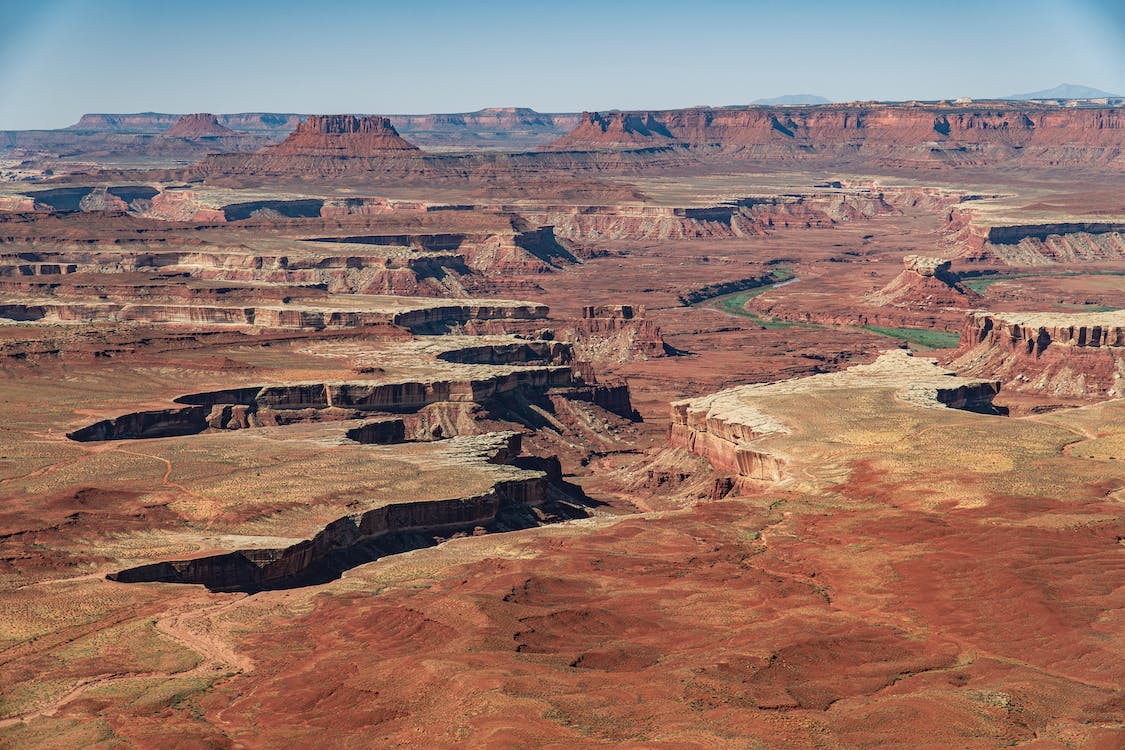Standing as the largest national park in Utah, Canyonlands National Park preserves a colorful landscape eroded into numerous canyons, mesas, and buttes by the Colorado River, the Green River, and their respective tributaries.
There are four districts in which the park is divided: the Island in the Sky, the Needles, the Maze, and the combined rivers—the Green and Colorado—carved two large canyons into the Colorado Plateau. Although the areas share a primitive desert atmosphere, each retains its character. Author Edward Abbey, a frequent visitor, described the Canyonlands as “the weirdest, wonderful, magical place on earth—there is nothing else like it anywhere.”
History of the Park
Bates Wilson, Arches National Monument Superintendent, advocated creating the Canyonlands National Park in the 1950s and early 1960s. The Canyonlands park bill was then introduced in 1962 by Utah Democratic Senator Frank Moss. On the same year, a paper entitled A Proposed Canyonlands National Park published by the U.S. Department of the Interior contained evocative passages such as:
“Rock — carved, colored and clothed by weather — controls the character of our land. Nowhere is the relationship between earth’s framework and the forces that shape it more dramatic than in the plateau and canyon country of the American Southwest.”
This Moss legislation was introduced in the early August 1961, to establish Canyonlands National Park. The bill called for a 300,000 acres park to protect the three major scenic areas—Island in the Sky, the Needles, and The Maze. The federal owned almost ninety percent of the land, and the state of Utah held the remaining. It would only be acquired by purchase or through an exchange of public domain outside the proposed park boundaries. Included in the bill was the multiple-use provisions that permitted grazing and mining but not hunting.
On September 12, 1964, the Canyonlands was established as a national park by virtue of President Lyndon B. Johnson signing Public Law 88-590. On November 12, 1971, the park expanded to 337, 598 acres as the Maze, the Land of Standing Rocks, and Davis and Lavender canyons were added (Public Law 92-154).
Flora and Fauna
The desert bighorn sheep, one of Utah’s few remaining native herds, roams the park and just strays near its water sources. There are about 273 bird species found abundant near streams and rivers of the park. Listen to the park’s songsters with canyon wrens in steep-walled canyons, western meadowlarks in the grasslands, black-throated gray warblers in the piñon-juniper woodlands.
You can enjoy colorful blooms in May with orange globemallow, claret cup cactus, Indian paintbrush—as yellowy stands of cliff rose release a potent fragrance. The sego lily, Utah’s state flower, is a rare find.
Activities to do in the Park
Island in the Sky
This is one most famous spots and is the easiest way to see the Park. With only 32 miles from Moab, it offers many pullouts with spectacular views along the paved scenic drive. It sits above a massive 1500 foot mesa, quite literally an Island in the Sky.
With 20 miles paved road, you can forward to most impressive views in Canyon Country. View from over 100 miles (161 km) in any given direction can be seen by visitors, resulting in panoramic views that encompass thousands of square miles of canyon country.
You can have a short day-hike or spend a relaxing late afternoon to enjoy the sunset. From a few hours to a few days’ stay, the Island in the Sky offers an unforgettable Canyon Country experience for you and your company.
The Needles
It’s “just around the corner” from Island in the Sky. This has a lesser crowd and offers great hikes, and more scenic views from uniquely shaped sandstone rock formations create stunning landscapes.
You can reach The Needles through US-191. It takes a 2-hour drive from the Island in the Sky visitor center.
The Maze
There is no other way but to have a 4×4 ride to The Maze due to its remoteness. Bring extra self-sufficiency and some backcountry experience when exploring this area of the Canyonlands National Park.
Mesa Arch
Well-known for its unique lighting at sunrise, this is a favorite spot for tripod-wielding photographers first thing in the morning. This is a busy spot all day long, as numerous visitors take the opportunity to capture this unique in a lifetime experience.
You will reach Mesa Arch via a half-mile hike round trip. After a 10-minute drive from the visitor center, you can get here or through a leisurely walk on a path up with graded gravel and dirt and over a small hill.
Gooseberry hike
This hike is a journey below the rim’s level and treks out to the edge of one of the canyons formed by the Colorado River with features of crazy steep descent to get down to the plateau level. This out and back hike require a climb back up the steep wall of rock. However, the views are gorgeous on the way down that makes this hike worth. And there is something special about touring below the rim in the Island of the Sky.

